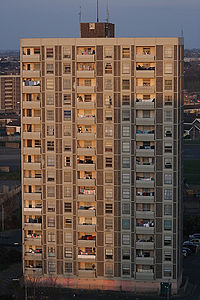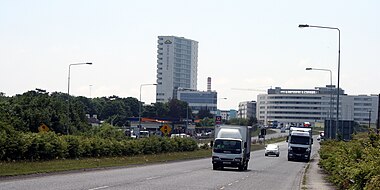Ballymun
This article needs additional citations for verification. (January 2010) |
Ballymun (Irish: Baile Munna) is an area on Dublin's Northside close to Dublin Airport, Ireland. It is infamous for the Ballymun flats, which became a symbol of poverty, drugs, alienation from the state and social problems in Ireland from the 1970s. Today it is undergoing a multi-billion euro renewal, with a renovated village centre, surrounded by estates of houses and apartments, with several sub-districts such as Sillogue and Poppintree.
Ballymun had a population of 22,109 at the 2006 Census.
Amenities
Today Ballymun has a wide range of amenities, from green spaces and the public Silloge Golf Course to a Tesco-anchored but very run-down shopping centre, a range of other shops and pubs and a hotel, to a public sector office development, with many branches of the city government (including a Motor Tax and Driver Licence office) and the Health Service and a very modern public leisure centre. There is a church in the old village centre, and a number of schools, including a Gaelscoil (Irish-speaking) primary school.
Transport
Ballymun is served by a number of Dublin Bus routes. The area is also to have an underground stop on the planned Metro North (Dublin city centre to Swords) line of the Dublin Metro. Journey time from Ballymun to the airport is estimated be around three minutes, and to Dublin city centre around twenty-five minutes.[1]
History and nature
The current town of Ballymun is not in the area historically called Ballymun; instead, it is in several townlands, the most significant of which was Stormanstown. The nearest village was Santry Village, property of the Domville family.
Due to what were seen to be undesirable associations, some say that the area has shrunk since the completion of the tower blocks. For instance, in the early days of Dublin City University, then called NIHE, Dublin, this institution was sometimes referred to as being in Ballymun (part of the "Ballymun Project"), or sometimes in Whitehall, whilst today it is referred to and has a postal address in Glasnevin even though it has not changed location. Indeed, much of the present day central Ballymun lies on lands once in the northern reaches of the Albert Agricultural College estate, the forerunner of the present-day Dublin City University (D.C.U.).
Streets have also been renamed. For example, Ballymun Avenue was renamed Glasnevin Avenue after a local plebiscite in the 1970s.
Ballymun Avenue was first known as Santry Avenue Extension, then Ballymun Avenue, then Glasnevin Avenue.
Books about Ballymun
In September 2006, Gill & Macmillan published The Mun, by Lynn Connolly. This is a memoir covering the history of Ballymun from its inception to the final regeneration of the town. The Mun was Lynn's account of another side of Ballymun, of which she has fond memories. She wrote of a side of Ballymun not written of in the press stories about drug dealing and gangsters; a community that thrived in spite of the squalor. The Mun was Lynn's way of putting the story straight for the decent people of Ballymun.
In April 2009, Irish publisher Gill & Macmillan published Ballymun resident Rachael Keogh's account of her life as a heroin addict, Dying to Survive. Rachael started taking drugs aged 12 and for the next 15 years was hooked on a variety of substances. In 2006, after repeated attempts to get help, Rachael went to the media to publicise her plight.
Ballymun tower blocks

Among the opprobrium heaped on Ballymun, the deployment of the flats has been described by the environmental journalist Frank McDonald, in his book The Construction of Dublin, as the Irish state's 'worst planning disaster'. However, at the time of its construction, Ballymun was a sought after location and prospective tenants had to pass an interview to get housing there. There were three types of flats: seven fifteen-storey towers; nineteen eight-storey blocks; ten four-storey blocks. The flats were built in the 1960s under the authority of Neil Blaney, the then Fianna Fáil Minister for Local Government. They incorporated the best social housing practice of the time. The first tenants moved in between August 1966 and December 1966. By February 1969, when the National Building Agency's contract for Ballymun ceased and control of Ballymun was handed to Dublin Corporation (Dublin County Council didn't want it), there was a total of 3,021 dwellings in the new Ballymun, all of which was social housing under the control of the Irish state through Dublin Corporation (the Corpo).
The tenants primarily came from the most deprived areas of inner city Dublin, places where the depth of poverty could not be conceived of in modern Ireland. Many tenants were middle class residents whose property was 'compulsory purchased' by Dublin City Council. They arrived in Ballymun to some of the finest social housing in Europe, having central heating and other rarities of the day in their homes.
However, there was a profound lack of amenities throughout the area - initially the only shop was a van selling at premium prices, for example - and, combined with a lack of trees, and estates built in cul de sacs, ghettoisation developed. The earliest efforts to improve services began in the 1970s with the establishment of tenants' associations, particularly in Sillogue. By the recession of the 1980s, Ballymun was infested with social problems, most especially alcohol and other drug abuse. Although the public image of Ballymun has changed somewhat since the beginning of the Ballymun regeneration project in 1997, continuing social problems in Ballymun ensure it remains a remarkably different world to, for example, neighbouring Glasnevin.
Regeneration of Ballymun

The creation of Ballymun Regeneration Limited as a limited company controlled by Dublin City Council initiated the beginning of the demolition of the Ballymun flats and the emergence of a "new town" of Ballymun. As of 2008[update], six of the seven towers (Pearse, Ceannt, Macdermott McDonagh, Connolly, and Clarke) as well as three eight-storey blocks and seven four-storey blocks have been demolished by DSM, with the residents generally rehoused in new "state of the art" housing in Ballymun. The new housing is a mixture of public, private, voluntary and co-operative housing. The "new Ballymun" is due to be completed by 2013. A documentary film entitled Ballymun Lullaby was released in February 2011 and includes scenes detailing the regeneration of Ballymun as well as its impact on the culture of its populace.[2]
The regeneration project, despite well-publicised questions about accountability and democratic participation, has also delivered many other amenities, including reworked park areas, a major City Council office facility, Health Service facilities, a public leisure centre, student accommodation, a new hotel and renewed shopping areas. A film of the leisure centre by filmmakers Joe Lawlor and Christine Molloy, LEISURE CENTRE, was made in 2007 and starred hundreds of Ballymun residents. See here for details.
As part of the New Ballymun, a major tree-planting project called Amaptocare has been run, with more than 600 people sponsoring around 700 trees, and providing inscription texts which are engraved on plaques near the trees. All of the trees will be identified on a glass panel at Ballymun's central plaza, which was scheduled to be complete by 2007 but is now due by 2013.
Ballymun Mini-Ghaeltacht
There are plans to create a small Irish speaking community in Ballymun, consisting primarily of 38 homes, centered around the Gaelscoil that is already in the area, as well as an Irish speaking shop in the locality and the local branch of Glór na nGael. The project has a set completion date in 2012 with construction hoped to begin by the end of 2011.
Sport
There are a number of local sports groups, including football club Ballymun Kickhams GAA, setanta hurling club, Ballymun United Football Club and St Pats United/Ard Celtic FC. Unidare RFC, who came runners-up in the 2007/08 Dublin Metro League, did so with a panel of players drawn heavily from the Ballymun area and young players from Ballymun now play at all youth levels for the club.[3]
Notable residents
- Barney Rock, Gaelic footballer
- Glen Hansard, musician
- James McCarthy, Gaelic footballer
- Philip McMahon, Gaelic footballer*
See also
References
- ^ http://www.dublinbus.ie/en/Your-Journey1/Timetables/All-Timetables/13a/
- ^ "Documentary Ballymun Lullaby".
- ^ See, Emerald Rugby Magazine, October, 2007
External links
- The Seven Towers, Ballymun
- New Ballymun dot com
- Ballymun Regeneration Ltd, with much about all aspects of the regeneration
- Photos of the demolition of one of the flats
- News about Ballymun and Ballymun Partnership
- Ballymun United Football Club
- Ballymun Kickhams GAA Club
- Unidare RFC
- Ballymun Boilerhouse Competition
- Gill & Macmillan
- Dying to Survive
53°24′N 6°17′W / 53.400°N 6.283°W
